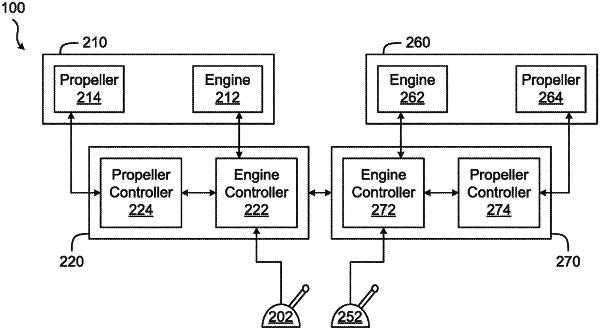| CPC B64D 31/12 (2013.01) [B64C 11/30 (2013.01)] | 20 Claims |

|
1. A method for producing reverse thrust in a multi-engine propeller aircraft, comprising:
obtaining, at a first engine controller of a first engine of the aircraft, a first power request for the first engine to produce reverse thrust;
determining, at the first engine controller, a first blade angle for a first propeller coupled to the first engine, the first blade angle determined to assess, at the first engine controller, a readiness of the first engine for producing reverse thrust based on the first power request;
obtaining, at the first engine controller and from a second engine controller of a second engine of the aircraft, a second power request for the second engine to produce reverse thrust, the first engine controller and the second engine controller communicatively coupled to one another without being arbitrated by a central controller;
obtaining, at the first engine controller and from the second engine controller, a second blade angle for a second propeller coupled to the second engine, the second blade angle obtained to assess, at the first engine controller, the readiness of the second engine for producing reverse thrust based on the second power request;
providing, to the second engine controller and from the first engine controller, the first power request and the first blade angle, the first blade angle used by the second engine controller to assess the readiness of the first engine for producing reverse thrust based on the first power request, and
when the first and second blade angles are beyond a predetermined threshold, commanding, via the first engine controller, the first engine to produce reverse thrust based on the first power request and substantially synchronously, commanding, via the second engine controller, the second engine to produce reverse thrust based on the second power request.
|